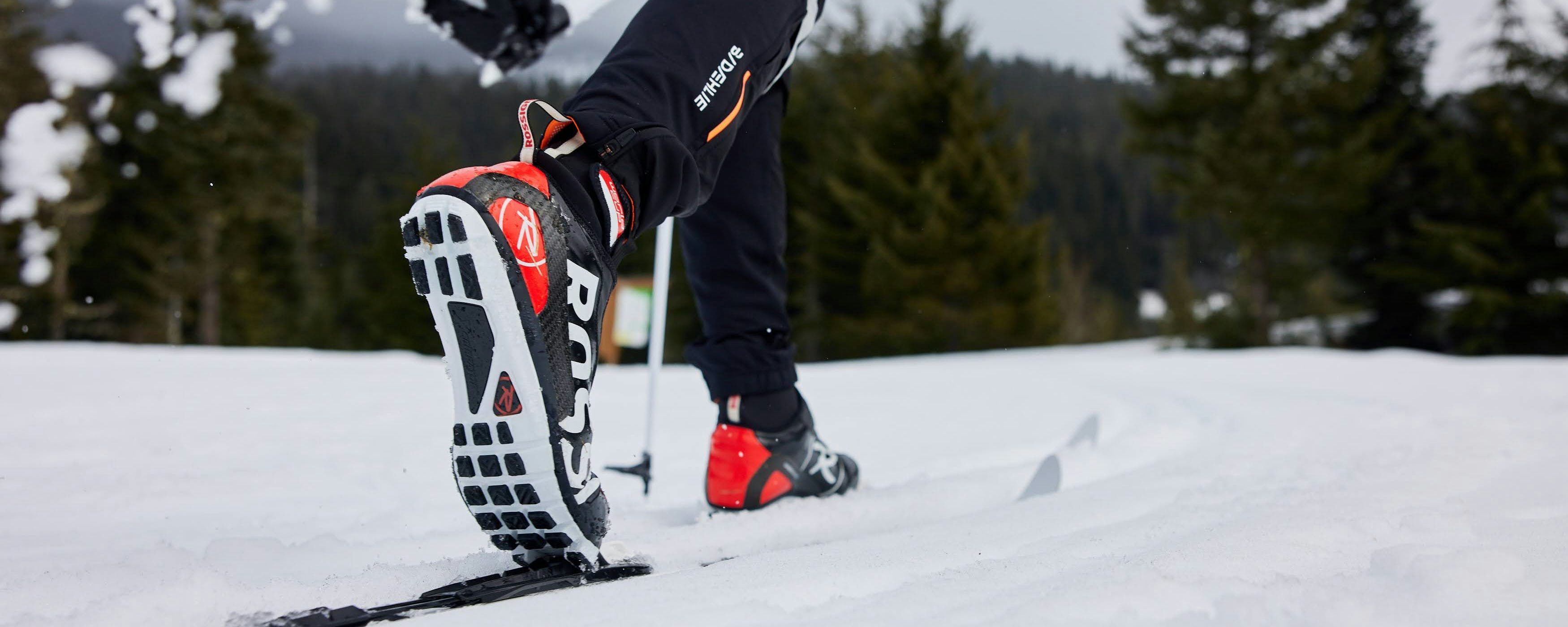Cozy layers? Check. Skis? Check. Boots…? Before you can hit the trails for a day of cross-country skiing, you’ll need cross-country ski boots that fit your feet, as well as your skis.
If you’re new to cross-country skiing, you may not realize just how much of a cardio workout it could be – and how important it is to choose well-fitting boots. Think of it like running: while choosing a pair of running shoes, you’d prefer to wear a snug and light pair, right? That’s the same angle you’ll be aiming for with cross-country ski boots.
When it comes to choosing your first cross-country ski boots (or if you’re upgrading), there are a few factors to consider:
- Your ski bindings: You’ll need to make sure your boots are compatible with your bindings.
- The type of cross-country skiing you’ll be doing: Whether it’s the dynamic skate style, the more traditional classic method or offtrack.
- Getting the correct boot size: Find boots that fits the width, length and shape of your feet.
- Finding the right fit: One of the most important aspects – you’ll need boots that just feel right.
Make sure you have the right bindings
Not all boots fit with every type of binding. Find out about the two main systems – NNN and NNN BC, and check out the tech specs on each product at MEC to see what you’ll need to match.
NNN system The general, common cross-country ski bindings are the NNN type (which stands for New Nordic Norm). They have a single metal bar at the toe and attach to your skis bindings by going in toe-first. NNN boots are compatible with NNN bindings, but also match with alternative styles like Prolink and Turnamic.
NNN BC system
NNN BC boots are the backcountry or offtrack skiing version of NNN. The bar at the toe is thicker, and the boots themselves have wider, deeper channels at the bottom. NNN BC boots are not compatible with NNN bindings, so be sure you have the proper match while choosing your gear.
Types of cross-country ski boots
Cross-country skiing usually divides into two main categories: classic and skate. However, if you’re more experienced and looking to go off the beaten track, offtrack skiing is another method that has its own unique style of boot. Depending on what type of skiing you’re doing, you’ll want boots that are designed for that category.
Classic skiing
This method lives up to its name, as it’s a tried-and-true way to cross-country ski, especially for beginners. It’s the stride-and-glide motion that works best in groomed tracks, as you move your skis forward one at a time. Classic cross-country ski boots tend to be more flexible. This added flex allows you to easily lift your heel while you glide down the trails.
Skate skiing
Remember what we said about thinking of cross-country ski boots like a pair of running shoes? That’s especially true for skate boots. This dynamic style of skiing is highly aerobic, requiring you to propel yourself forward by pushing off the ski’s edges. Since it’s more of a workout, skate ski boots are more rigid, tight and lightweight to give your feet a sturdier hold while you move. Cuffs on the ankles provide more stability and power as you push off.
Off-track skiing
Off-track skiing is for those who come prepared. Before heading into the ungroomed and untouched snow, make sure you’ve done the proper research on the area you’ll be exploring. This type of skiing also requires a unique type of boot: the off-track touring boot. They’re like winter hiking boots and have more insulation and tougher materials. Since you’re not on groomed trails, you could find yourself up to your knees in cold, wet snow. Boots that go up past your ankles will help keep snow out and your feet nice and toasty. Remember, touring boots use NNN BC bindings, which are different from the general NNN type.
Choosing the correct boot size
Cross-country ski boots generally use European sizing. To match the right size for you, take your normal shoe size and compare it with the size chart on mec.ca.
Finding the right boots that fit
While trying on cross-country ski boots, be sure to wear thick socks, like the kind you’d wear for a cold ski day. They can sometimes make a big difference on how snugly the right ski boot can fit.
Next, slide your heel all the way to the back of the boot after trying it on. The boot should be snug but comfortable around the widest part of your foot.
Not too tight, not too loose
Walk around for a while with both boots on, making sure there isn’t looseness or rubbing on your feet, as that can cause some uncomfortable blisters down the line.
While cross-country ski boots (especially performance oriented ones) should be tight on your feet, it should never be uncomfortable, as you don’t want to cut off any circulation. Flex the boots slightly by standing on your toes. If there’s pain in your forefoot or you can’t wiggle your toes, your boots are too tight.
Cross-country ski boots for kids
Kids tend to grow up fast, resulting in fluctuating sizes when it comes to their feet. Just getting into cross-country skiing? Check out gear swaps or secondhand cross-country set-ups to test out your kids’ comfort and go-to style of skiing before investing in a new pair.

